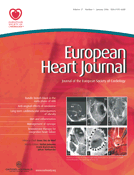-
PDF
- Split View
-
Views
-
Cite
Cite
Leslie M. Klevay, Heart failure improvement from a supplement containing copper, European Heart Journal, Volume 27, Issue 1, January 2006, Page 117, https://doi.org/10.1093/eurheartj/ehi634
Close - Share Icon Share
Witte et al.1 improved ventricular function and quality of life in septuagenarian patients with chronic heart failure and ischaemic heart disease by supplementation with multiple micronutrients.The authors suggested that their regimen may provide relief from multiple deficiencies, reduction in oxidative stress, and be a first step towards identifying elements that can be eliminated from the supplement without loss of benefit. Copper is an antioxidant nutrient for cardiovascular health2 that may have contributed to their success.
The Western diet is often low in copper,3 according to the pooled data from several articles on more than 900 diets chemically analysed. About 62 and 36% of diets of 80 randomly selected adults in Baltimore4 were below the recommended dietary allowance and the estimated average requirement for adults, respectively, 0.9 and 0.7 mg daily.5
Copper deficiency is the only nutritional insult that elevates cholesterol, blood pressure, homocysteine, and uric acid, has adverse effects on electrocardiograms and arteries, impairs glucose tolerance, and promotes thrombosis and oxidative damage. More than 80 anatomical, chemical, and physiological similarities between animals deficient in copper and people with ischaemic heart disease have been identified.6,7 Copper deficiency in animals can induce cardiac enlargement,8 pleural effusion,9 and heart failure10 that are reversible with copper supplementation.
Dietary supplements including copper in this context may be inexpensive therapy rather than expensive placebos. The small size of this trial reveals that a follow-up trial can be relatively inexpensive and need not involve hundreds or thousands of people common in heart disease research. Perhaps, a trial with two to three times as much copper and a decrease in vitamins to nearer international recommended intakes will produce benefit in a shorter time.
References
Witte KKA, Nikitin NP, Parker AC, von Haehling S, Volk HD, AnkerSD, Clark AL, Cleland JGF. The effect of micronutrient supplementation on quality-of-life and left ventricular function in elderly patients with chronic heart failure.
Allen KG, Klevay LM. Copper: an antioxidant nutrient for cardiovascular health.
Klevay, LM. Lack of a recommended dietary allowance for copper may be hazardous to your health.
Pang Y, MacIntosh DL, Ryan PB. A longitudinal investigation of aggregate oral intake of copper.
Anon. Copper. In:
Klevay LM. Ischemic heart disease. In: Bogden JD, Klevay LM, eds.
Klevay LM. Advances in cardiovascular-copper research. In: Schrauzer GN, ed.
Dallman PR. Cytochrome oxidase repair during treatment of copper deficiency: relation to mitochondrial turnover.
Viestenz KE, Klevay LM. A randomized trial of copper therapy in rats with electrocardiographic abnormalities due to copper deficiency.



